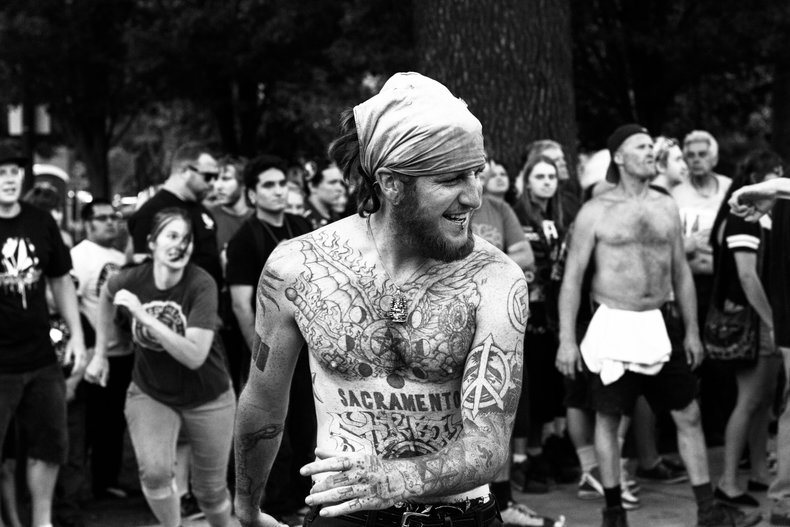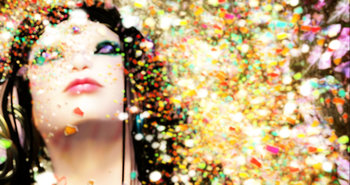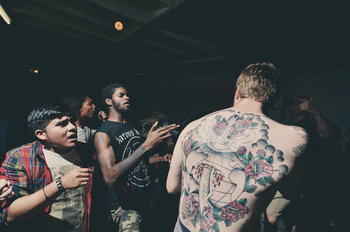|
| |
Modern culture is the set of norms, expectations, experiences and shared meaning that evolved amongst the people of the modern-era. This began as early as the renaissance and ran as late as 1970. The current period of world culture is presently considered postmodern or contemporary with some chance that the future will classify us as modern. The following are illustrative examples of modern culture.SecularismThe separation of religion from other concerns such as government and business. Secularism is a basis for the diverse societies such as the United States that boomed in the modern-era.AmericanizationThe United States was born in the modern-era and grew rapidly in the Gilded Age to dominate the world economy and important industries such as the film industry. As such, American ideas and culture spread on a global basis in this period.
IndividualismThe Declaration of Independence of the United States cites three unalienable rights -- life, liberty and the pursuit of happiness. Both liberty and the pursuit of happiness relate to individualism. These values, born out of the French Revolution, came to define modern culture whereby people became more independent and individualistic.AnomieIndividualism puts less constraints on the individual but it also provides them with less direction and automatic inclusion. Where some individuals thrive in this environment, others are likely to feel lost and disconnected with little sense of shared meaning. This is known as anomie and it is a common feature of modern societies.Specialization of LaborOne of the significant innovations of the industrial revolution was to organize labor into highly specialized roles. This had a large impact on working culture and conditions. For example, the workstations on an assembly line whereby a worker might add a single part to assemblies all day long. This greatly increases productivity but tends to make work less satisfying and more grueling. As office work emerged as a major employer, this specialization of labor continued. For example, an accountant who works in a particular screen all day long.Automobile CultureThe proliferation of automobiles completely transformed the lifestyles and landscapes of nations from the beginning of the 20th century. Automobiles gave people the freedom to travel at speed as individuals, families or small groups. This created pleasantries such as road trips and miseries such as long commutes and traffic jams.Modern ArtModern art is characterized by movements such as Romanticism, Impressionism, Fauvism, Expressionism, Neo-impressionism, Cubism, Futurism, Abstract Expressionism, Pop Art and Hyperrealism that begin amongst a small group of artists who want to challenge the status quo of the art world. These movements then spread on a global basis until they become the new status quo that is accepted as high culture.Modern ArchitectureGenerally speaking, early 20th century modern architecture is a reaction against the commoditization created by industrialization with unique and crafty architectures that are unsuitable for mass production. After 1940, a shift towards minimalism occurs whereby architecture that is ideal for mass production begins to dominate. For example, white rooms and boxy concrete forms with no ornamentation. Another common characteristic of late modern architecture, is dematerialization whereby materials are stripped away to the bare minimum. Again, this is ideal for industrial scale and the optimization of unit cost.Generation Gaps In 1900, around 18% of the industrial workforce in the United States were children. Federal child labor laws were passed in 1916 and 1918 but both were overturned as unconstitutional. Nevertheless, childhood began to change after WWI as working became less common and extended years of schooling became the norm in affluent countries. This allowed youth the free time to develop their own culture leading to large generation gaps beginning in the 1920s whereby young experimented with music, fashion, lifestyles and values that differed markedly from that of their parents.Shared ExperienceBroadcast media and films allowed for shared experiences across millions and to some extent billions of people. Shared experience expanded from the scale of cities and villages to the scale of nations. For the first time, global experiences were possible.GlobalizationTechnologies such as the telegraph, steamship, telephone, radio, television, airplane and computer network made the world feel much smaller. Global trade flourished and large populations gained access to goods from every corner of the world. Travel and migration greatly increased such that it became increasingly common to have direct experience of different national cultures.CosmopolitanismCosmopolitanism is the idea that culture exists at a global level whereby norms, expectations and shared meaning can span the globe and allow people with different backgrounds and experiences to interact productively and pleasantly.Pizza EffectThe pizza effect is the tendency for cultures to emulate each other. Each copy is slightly imperfect resulting in new culture. This is a vital process that produces new culture and has greatly accelerated with globalization.Popular CulturePop culture is the industrial production of culture at scale. For example, a restaurant chain that serves billions of customers or a song that is heard by half the people on the globe.Scientific RevolutionScientific and engineering knowledge rapidly increased beginning in the Renaissance. Each new advancement helped the next advancement to come more quickly. Technology became so complex that people began to view it much the way they view magic. This created both enthusiasm and dread -- as cultures grappled with the ever accelerating pace of change and new risks that technologies brought. For example, the Cold War whereby large ideologically opposed civilizations suddenly had the power to essentially destroy the world with nuclear weapons.Consumer CultureThe modern-era is characterized by a thriving capitalist economy whereby producers compete to meet every need and preference of the consumer. This resulted in a commoditization of experience whereby producers offer products for every element of the human experience. For example, a bus tour or video game that serves the human need for adventure, exploration and epic meaning. Comfort & ConvenienceAs firms compete to produce anything that customers prefer a race to the bottom can occur whereby everything is made sweeter, more comfortable, safer and more convenient. Middle ClassCapitalism and industrialization brought large surpluses of value creation. For the first time, large portions of society earned a discretionary income that could be saved, invested or spent on luxuries. People began to expect much more than mere survival and sought experience or self-improvement. This resulted in an explosion in culture whereby far more resources were poured into films, literature, design, architecture, fashion, sport, music, games, festivals and holidays -- anything that gives life meaning and color.Leisure ClassHistorically, it was only the very poor and very rich who had any free time. This changed over time as the productivity rate grew due to industrialization and workers could generate significant value in less time. For example, the average American manufacturing work week was 69.1 hours in 1830, 59.6 hours in 1900 and 38.7 hours in 1950. This combined with the discretionary income of the middle class greatly expanded access to leisure activities such as travel. Urbanization & SuburbsGreat cites grew in the modern-era. With the introduction of the automobile, these grew outward creating large suburbs. These two modes of living lead to vastly different lifestyles and cultures whereby the suburbs are more isolated and family-oriented and urban cores are more vibrant, lively and intense.Creative TensionThe modern-era was born in the Renaissance whereby new ideas were spread by printing presses. This later expanded to the printing of books and newspapers at scale in the Industrial Revolution. With the introduction of radio and television in the 20th century, information could be beamed directly into the home. These media allowed new ideas to flow quickly. Creative tension thrived around ideology, politics and current events.RelativismRelativism is a distant type of individualism and skepticism whereby one rejects the notion of universal truths in favor of the view that individual subjective reality is the only thing that's real. This idea had some influence on the modern-era but is considered one of the defining features of the postmodern-era. This challenges the basic assumption that people have any shared reality whatsoever or that truth and evidence have any meaning beyond the individual. NotesEvery age views itself as separate and unique from history. As such, it is currently common to assume that we have emerged from the modern-era into something vaguely defined as postmodern. It remains to be seen how this age will be classified by history.The term modern culture is typically used to denote the culture of developed nations in the modern-era.
Modern Culture
This is the complete list of articles we have written about modern culture.
If you enjoyed this page, please consider bookmarking Simplicable.
ReferencesRoark, James L. The American promise: A history of the United States. Vol. 2. St Martins Press, 1998.
The defining characteristics of the modern era.
An overview of the major styles of modern art with examples of each.
The defining characteristics of modern architecture.
The defining characteristics of modernism.
An overview of the Gilded Age of American history.
The basic characteristics of Art Nouveau with examples.
An overview of the jazz age.
An overview of modern technology with examples.
An overview of culture.
The definition of literature with examples.
A vocabulary for describing music.
An overview of the art world.
An overview of American culture with examples.
An overview of digital culture with examples.
The definition of humanity with examples.
An overview of potential pros and cons of globalization.
A list of common culture factors.
TrendingThe most popular articles on Simplicable in the past day.
Site Map
© 2010-2023 Simplicable. All Rights Reserved. Reproduction of materials found on this site, in any form, without explicit permission is prohibited.
View credits & copyrights or citation information for this page.
|



























































